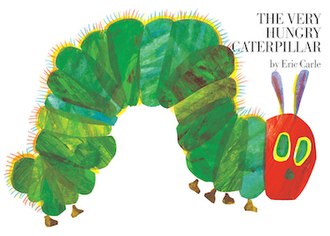The Very Hungry Caterpillar

The Very Hungry Caterpillar is a children’s picture book designed, illustrated, and written by Eric Carle, first published by the World Publishing Company in 1969, later published by Penguin Putnam.[1] The book features a very hungry caterpillar who eats his way through a wide variety of foodstuffs before pupating and emerging as a butterfly. The winner of many children’s literature awards and a major graphic design award,[2] it has sold almost 50 million copies worldwide.[3] It has been described as having sold the equivalent of a copy per minute since its publication, and as “one of the greatest childhood classics of all time”.[4] It was voted the number two children’s picture book in a 2012 survey of School Library Journal readers.[5]
The Very Hungry Caterpillar is Carle’s third book, and uses distinctive collage illustrations that were innovative at the time of publication, ‘eaten’ holes in the pages, and simple text with educational themes – counting, the days of the week, foods, and a butterfly’s life stages. It teaches children how to count and to make one-to-one correspondences between numbers and the items the Very Hungry Caterpillar has eaten. There have been many related books and other products, including educational tools, created in connection to the book. The Very Hungry Caterpillar’s diet is fictional rather than scientifically accurate, but the book introduces concepts of Lepidoptera life stages where transformations take place including the ultimate metamorphosis from ‘hungry caterpillar’ to ‘beautiful butterfly’, and it has been endorsed by the Royal Entomological Society.
First shown on a Saturday night, by the light of the moon, an egg lies on a leaf. When the egg hatches early Sunday morning, the newly born insect is revealed as a caterpillar. The text describes him as “a tiny and very hungry caterpillar”. By the name of the insect, he begins to look for something to eat. He eats through increasing quantities of fruit for the following five days (Monday through Friday). First he starts with one apple on Monday, then two pears on Tuesday, then three plums on Wednesday, four strawberries on Thursday, and five oranges on Friday. Each of the days repeat the line, “But he was still hungry”. On Saturday, he eats a piece of chocolate cake, an ice-cream cone, a pickle, a slice of Swiss cheese, a slice of salami, a lollipop, a piece of cherry pie, a sausage, a cupcake, and a slice of watermelon. That night he gets a stomachache from overeating.
The next day (Sunday again) the very hungry caterpillar tries again and begins by eating one green leaf, and afterwards feels much better. Then, on the following day (Monday again) the caterpillar is no longer hungry, and is no longer little; he has grown in size (being a big, fat, caterpillar). The now-big caterpillar spins a chrysalis[a] around himself. Once inside, he stays inside for at least two weeks. After two weeks, the caterpillar nibbles a hole in the chrysalis and pushes his way out. Finally, he develops into a butterfly with large, gorgeous, multi-colored wings. Now a butterfly, the butterfly cycle starts again. The story follows a caterpillar’s actual life cycle: first eating leaves and growing into a big and fat caterpillar, then spinning a chrysalis, and finally metamorphosing into a butterfly.
